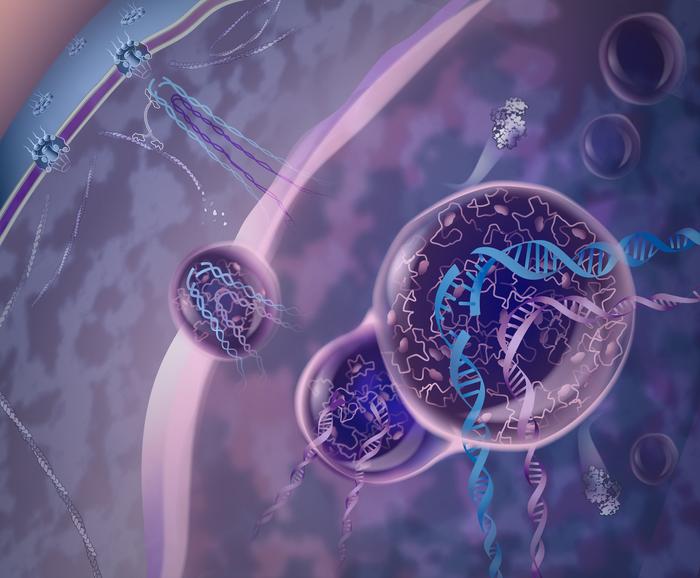When a cell experiences DNA breaks, the implications for cellular stability and overall genomic integrity can be devastating. Such damage is especially concerning in regions of the genome that are notoriously challenging to repair. Researchers from the USC Dornsife College of Letters, Arts and Sciences, led by scientists Irene Chiolo and Chiara Merigliano, have unveiled a groundbreaking discovery about a protein named Nup98. Historically recognized for its role in facilitating the transport of molecules across the nuclear envelope, Nup98 has revealed itself to play a crucial part in guiding precise DNA repair processes, thereby mitigating the risks of genetic errors that can lead to cancer.
Their research, published in the esteemed journal Molecular Cell, dives deep into the cellular mechanics of Nup98, which forms droplet-like structures within the nucleus. These unique condensates serve as protective bubbles enveloping damaged DNA strands, particularly in regions known as heterochromatin. These areas of the genome are densely packed with genetic material, leading to complicating factors during the repair process due to the presence of repetitive DNA sequences. The presence of Nup98’s droplets acts to shield damaged sections from the surrounding chaos and introduces a safer environment that fosters accurate repairs, thus curbing the potential for significant genetic mix-ups that could precipitate cancer development.
The study emphasizes the importance of heterochromatin, a vital area of Chiolo’s research focus. Due to the tightly coiled nature of this genetic landscape, cells are at heightened risk of misidentifying strands of DNA during the repair process. Nup98’s strategic manipulation of these condensates assists in extracting the damaged DNA from the clutches of heterochromatin, promoting an environment conducive for repairs. This spatial reorganization is crucial not just for repair accuracy but also for cellular survival.
In an added layer of complexity, Nup98 is integral in orchestrating the timing of DNA repairs. This protein ensures that certain repair proteins do not rush to the scene prematurely, which is critical as early intervention can lead to incorrect repairs. A specific example cited in the research is Rad51, a protein that mistakenly binds and connects misaligned DNA fragments when it arrives too early. Nup98’s droplet structures effectively shield damaged DNA from Rad51 until it’s appropriately prepared for the final repair steps. The research highlights that Nup98’s droplets serve as a temporary protective measure, allowing more organized molecular activities to precede the repair process.
The timing of these molecular interactions is not simply a matter of convenience; it is fundamental to preserving genomic integrity and preventing dangerous genetic rearrangements. With each step in this intricately staged process, Nup98 plays a central role in ensuring that cells maintain stability within their genome — a key determinant in thwarting both cancer progression and the aging process. This finely tuned coordination is increasingly recognized as an essential mechanism in the maintenance of cellular health.
Although the study primarily focused on cells from fruit flies, the discoveries made hold significant relevance for understanding analogous DNA repair mechanisms in humans. A notable takeaway from this research is that many of the fundamental DNA repair pathways observed in fruit flies have counterparts in human biology. Such similarities render fruit fly models instrumental in further elucidating the pathways that uphold genome stability across species.
Moreover, the identification of Nup98’s role in DNA repair could have transformative implications for addressing diseases like acute myeloid leukemia (AML). Mutations in the Nup98 gene have been implicated in various cancers, including AML, emphasizing the critical need to interrogate how these mutations might disrupt the protective mechanisms that Nup98 typically provides. The findings may pave the way for the development of targeted therapies that disrupt cancerous cells and create strategies for harnessing these mutations into therapeutic targets.
Research endeavors like this illuminate the intricate dance of cellular components that interact to safeguard the genome. As understanding the fundamentals of these processes evolves, so too does the prospect of developing therapies that could either enhance or mimic Nup98’s protective functions. By bolstering the cellular machinery responsible for DNA repair, scientists hope to reduce the risk of genomic instability — a pressing concern not only in cancer pathogenesis but also in age-related diseases and other disorders characterized by genomic instability.
The implications of this research extend far beyond the immediate findings. With a collaborative effort spanning across several institutions worldwide, the study involved the expertise of 17 scientists, opening the floor for future inquiries into novel treatment strategies that target the intricate pathways of DNA repair. As researchers continue to peel back the layers of complexity inherent in cellular processes, the potential for groundbreaking insights improves exponentially.
The fusion of theoretical knowledge and experimental practice can lead to a profound understanding of cellular mechanics, and the Nup98 findings serve as a prime example of how basic research can ultimately inform clinical applications. With ongoing efforts to extend these insights into human health contexts, the future holds promise for redefining therapeutic landscapes in cancer treatment and preventative strategies.
In conclusion, the role of Nup98 in coordinating the critical processes of DNA repair underscores a pivotal intersection of cellular biology and potential therapeutic application. The revelations from this study not only advance our understanding of genetic repair mechanisms but also set the stage for future explorations that could have meaningful impacts on human health — a testament to the power of scientific inquiry and collaboration.
Subject of Research: Cells
Article Title: Off-pore Nup98 condensates mobilize heterochromatic breaks and exclude Rad51
News Publication Date: 5-Jun-2025
Web References: https://doi.org/10.1016/j.molcel.2025.05.012
References: Molecular Cell
Image Credits: Illustration: Yekaterina Kadyshevskaya
Keywords
DNA repair, Nup98, heterochromatin, cancer, genomic stability, condensates, Rad51, acute myeloid leukemia, cellular mechanism, genome integrity, therapeutic targets.




